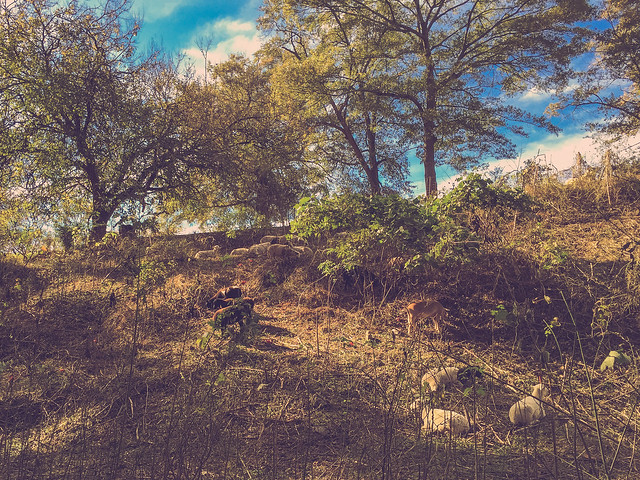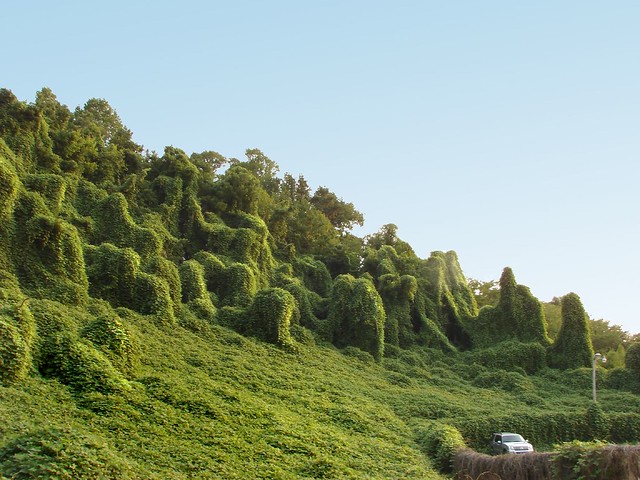Abundance & Usurpation while Building a DH Curriculum
The following was a position paper given at the Digital Humanities 2017 conference in Montreal as part of the “Challenges for New Infrastructures and Paradigms in DH Curricular Program Development” roundtable, chaired by Tanya Clement. I started that talk with a request I’ve not made before, asking audience members to refrain from tweeting the presentation. Frankly, I was nervous about some of these ideas bouncing around the social media echo chamber as decontextualized soundbites. I’m still a little nervous about that, to be honest, but I hope that taken as a whole my argument will make its specific points without being drafted into more universal service than it warrants.
 “Response to Print of Kudzu, Texas” by Laura Plageman
“Response to Print of Kudzu, Texas” by Laura Plageman
Let’s start with kudzu. Growing up in the American south, I was taught to fear this invasive species, which was introduced to the area in the 1930s to stymie soil erosion but then, the story goes, took over entirely, threatening to swallow the entire south: landscape, trees, buildings, and people alike. As a metaphor, kudzu was particularly fulsome, useful for representing any quality of the south (or its people) a given writer wished to eulogize. But, as Bill Finch describes in Smithsonian Magazine, “The myth of kudzu has indeed swallowed the South, but the actual vine’s grip is far more tenuous.”1 Finch explains that kudzu did in some ways remake the southern landscape, but to a lesser extent than people believe and in a very particular way. Rather than the “seven to nine million acres” the plant was estimated to cover in media, government, and even scientific accounts, when naturalists assessed its actual spread they found only “227,000 acres of forestland” affected.
What’s more, those areas of coverage are unevenly distributed, found primarily along the otherwise sparsely-vegetated sides of roads and railways.
The hype didn’t come out of nowhere. Kudzu has appeared larger than life because it’s most aggressive when planted along road cuts and railroad embankments—habitats that became front and center in the age of the automobile. As trees grew in the cleared lands near roadsides, kudzu rose with them. It appeared not to stop because there were no grazers to eat it back. But, in fact, it rarely penetrates deeply into a forest; it climbs well only in sunny areas on the forest edge and suffers in shade.
Still, along Southern roads, the blankets of untouched kudzu create famous spectacles. Bored children traveling rural highways insist their parents wake them when they near the green kudzu monsters stalking the roadside…It was an invasive that grew best in the landscape modern Southerners were most familiar with—the roadsides framed in their car windows. It was conspicuous even at 65 miles per hour, reducing complex and indecipherable landscape details to one seemingly coherent mass. And because it looked as if it covered everything in sight, few people realized that the vine often fizzled out just behind that roadside screen of green.
Bill Finch, “The True Story of Kudzu, the Vine That Never Truly Ate the South”, Smithsonian Magazine (2015)
In other words, kudzu has thrived in precisely the environments it was originally planted to shore up and in precisely the places people in an increasingly-car-dependent culture would see most frequently. Kudzu became such a source of anxiety because its success dovetailed almost precisely with people’s shifting centers of attention due to changing consumer technologies—because its visibility outran its actual role in the ecosystem.
I want to draw a parallel—perhaps an uneasy one, given that I don’t wish to alienate my colleagues at this conference—between kudzu in the American south and DH in the American academy, or at least in certain departments, such as my English Department at Northeastern University. I think kudzu can be a useful metaphor because it will allow me to acknowledge the anxieties of my colleagues about the ways DH is transforming our department—and to acknowledge that those fears have bases in reality—while simultaneously acknowledging the ways that anxieties about DH often stem from its unique visibility at this moment of larger change in the academy itself.
During MLA 2013, Natalia Cecire wryly observed on Twitter, “1. DHers usually don’t see dh as panacea. 2. Admins often do. 3. DHers often need for admins to have this erroneous belief.” Our experiences building a graduate DH curriculum at Northeastern in many ways illustrate this rhetorical tension. We benefit from substantial administrative support for curricular ingenuity while struggling to reconcile that support with increasing disquiet in the departments that must underwrite any substantive changes we seek to make.
Like kudzu, DH has been increasingly visible—perhaps even conspicuous—at Northeastern. Over just five years, our administration funded three years of cluster hires, which allowed us to bring DH faculty into the English; History; and Cultures, Societies and Global Studies departments, as well as adding DH faculty and staff in the library (I was hired in the first cluster). During the same period we founded a new center, the NULab; integrated both introductory and advanced DH courses into our curriculum; launched a DH graduate certificate program; and trained many students through work on locally- and grant-funded projects. This has in turn led to more students applying to our graduate programs seeking DH training. The first generation of grad students who participated in our DH initiatives have had notable success on the job market, as well, and we have been very proud to watch Northeastern Ph.D.s assume leadership roles in DH programs elsewhere.
 “Fissures” by thephotographymuse
“Fissures” by thephotographymuse
This rapid, wholecloth invention of a DH program, however, has been attended by pressures, fissures, and tensions with existing programs. Our DH cluster hires were a gift from the administration, given during a time when hiring requests in our humanities departments are more often denied than granted: a boon, perhaps, but also a sign of shifting institutional priorities which left colleagues outside DH’s ambit understandably unsure where they fit in the institution. Do I think we would have been able to hire a second medievalist, to cite a hypothetical example, had the NULab not come into being? I do not. But I also don’t think we should be cavalier about the very tangible ways the administration’s hiring priorities affect the programs, students, and curricula, and existing faculty and staff of the departments they impact. It means something when we hire a DH specialist and not a medievalist (yes, I understand that one could hire a digital medievalist—please just go with the example). The meaning of such a choice is not necessarily sinister, but hiring decisions are nonetheless among the most tangible and long lasting expressions of institutional will and aspiration, and they immediately shape curricula.
The NULab faculty hired at Northeastern have now developed a robust DH certificate program: the equivalent of 3 courses out of the 10 required in our English MA program or 14 required in our English Ph.D, plus the development of a small-scale DH project. Note: I discussed a slightly older version of the certificate in my presentation. For now that curriculum is also online. Our students take not only an introductory DH course, but also an advanced methods course (data modeling, text analysis, etc.) intended prepare them to integrate DH methods into their theses and compete for DH positions after graduation. I am overall quite proud of this structure, which offers a much deeper immersion in the field than is available in many other institutions, which may offer only a broad “Intro to DH” survey for graduate students (if that). I also believe that requiring both course and project work helps students develop expertise with aspects of DH work difficult to convey in a classroom setting, such as collaboration and project management. I am genuinely proud of the ways this program is helping our graduate students, and the current generation of graduate DHers at Northeastern are poised to do very big things.
Like kudzu along the roadway, however (or perhaps honeybees, originally an invasive species to the Americas that we’re now worried is disappearing) graduate curricula might be the most immediately visible sign of a shifting academic ecosystem, and the creation of our certificate program has spurred unintended organizational and political problems we should not dismiss out of hand. Within the NU English department, for example, completing the hours required for our robust certificate program requires students to decide their path almost immediately upon admission, and the decision to pursue the certificate dictates very particular routes through the larger Ph.D. program.
While our DH faculty are a larger group than at most institutions, even so we cannot practically mount more than two courses per year: an introductory course each fall and an advanced course each spring. Our graduate populations are themselves small and probably couldn’t support more than this, even if our faculty could. Under this paradigm, advanced courses rotate among NULab faculty and so have distinct foci shaped by our faculty’s interests and proficiencies. Given how much the curriculum relies on particular faculty members, it is subject to the vagaries of academic work and, ironically, success. As faculty at a research-focused institution, we are strongly encouraged to pursue fellowships and grants, but fellowships and grants can disrupt our certificate curriculum when the one person who can teach a particular advanced seminar suddenly disappears for a semester or year.
 “How to Escape from a Ski Jump” by Marco Nürnberger
“How to Escape from a Ski Jump” by Marco Nürnberger
Thus students’ options for completing coursework remain relatively constrained over two years of full time coursework in ways that do not always serve the particular training individuals need. A student primarily interested in digital archive creation, for instance, might by necessity take their advanced course in Humanities Data Analysis rather than Data Modeling; while the latter would be more appropriate to their interests, it can only be offered every three years or so, when particular faculty are on rotation for the advanced seminar. This isn’t necessarily a disaster—overall it’s probably in the interests of students to broaden their skills beyond what they think they will need. However, it does mean that even within a relatively thorough training paradigm DH students still rely more than I would wish on extracurricular skill development for their own research programs.
The pressures of time and planning in our certificate program are compounded for MA students in English or Public History. In the latter case we find there is really only one viable set of courses that can result in both a DH certificate and Public History credential within the timeline of both programs. Due to these challenges, NULab faculty are reevaluating how to align our high expectations for DH training with the practical realities of a certificate program, which must exist alongside and in harmony with the primary curricular structures of our humanities departments.
In addition to pressures on students, the popularity of the DH certificate among its first two cohorts of students has led to growing worry among departmental faculty that DH is driving down enrollments outside certificate program courses. We might be tempted toward market explanations (“we cannot dictate which courses students are interested in” or, less generously, “if our colleagues made their courses more enticing”) but these are neither sufficient nor reflective. The NULab has created a certification that students perceive as necessary in a competitive job market, despite ambiguity about the role of DH in securing jobs.2 Moreover, whereas another graduate course might be an option for fulfilling a distribution requirement—e.g. a Renaissance drama course is one way of fulfilling our pre-1800 course requirement—the strict track for the DH certificate means any particular DH course stands to be essential while any particular distribution-requirement course is more likely to be one option among others.
In other words, we have institutionalized a hierarchy of graduate course offerings that does in practice privilege DH courses over others in the curriculum for many of our students, in ways that partially reflect students’ interests, partly reflect their (entirely reasonable) anxieties, and partly reflect more mundane issues of organization and implementation. We cannot, in other words, entirely dismiss our colleagues’ worries about how DH, which belongs to no department in particular, has shifted the character and priorities of graduate programs in the particular departments of English and History. Assuming that a relatively large proportion of students in the DH certificate program also want to include DH elements in their theses or dissertations, we are faced with a advising bottleneck that could overtax DH faculty while leaving skilled colleagues without as many advisees as they could otherwise supervise.
 Untitled photograph by the US Department of Agriculture
Untitled photograph by the US Department of Agriculture
To return to our kudzu metaphor, our curricular challenges are partly based in reality and partly in perception. We offer precisely two DH graduate courses per year. It is simply not the case that DH classes have taken over the curriculum in English or History. We are not now nor will we ever be in the position of offering mostly DH courses. To cite another of our department’s specialities: rhetoric and composition courses are far more frequent in our English Department’s grad curriculum than DH courses (though there is welcome overlap between our writing and DH programs, and I am very convinced we might usefully compare earlier anxieties about the growth of distinct writing programs within or alongside English departments to current anxities about DH). Our DH curriculum is highly visible right now, however, because it runs alongside conversations about funding and enrollment. In other words, it seems to flourish in precisely the places we are focused on right now, in those spaces of particular anxiety in an age of austerity and existential panic within the humanities.
 “Sheep Clearing Kudzu” by Lee Coursey
“Sheep Clearing Kudzu” by Lee Coursey
Most southerners aren’t really worried about kudzu taking over anymore. Nor are they attempting to eradicate it from the byways where it has taken root. Instead, kudzu has become one part of the southern landscape. I expect this will be the case for digital humanities graduate training within our department. We need to get better about advising, so that individual students can discern whether the DH certificate will truly enhance their research and teaching, or whether they should focus their efforts in our department’s other specialties. We are also working with receptive colleagues to develop project options within a wider range of classes that can fulfill aspects of the DH certificate. Our hope is that this joint curricular development will serve as an invitation, as well as more equitably distribute our students’ DH desires and talents. We also hope it will help colleagues see how their expertise can complement, extend, and even prod the work of DH-interested students who might work with them on comps lists, theses, or dissertations.
 “Mathematical Disturbance” by Andrew Newill
“Mathematical Disturbance” by Andrew Newill
I do not believe we do ourselves any favors by denying the ways that DH is reshaping curricula, whether explicitly or indirectly. Instead, those of us in positions where DH has been privileged owe our colleagues a clear-eyed assessment of what has happened and why. Many of the changes wrought by the introduction of DH at Northeastern (and elsewhere) have been very positive. To cite the most obvious example for this conference, I believe the growth of such robust DH training opportunities will result in a wider, more diverse, and more interesting digital humanities in the next years and decades. But we must remember how rapid curricular changes ripple through the professional lives of our colleagues, and seek to encourage conversation and complementarity rather than rupture.
-
Bill Finch, “The True Story of Kudzu, the Vine That Never Truly Ate the South,” Smithsonian Magazine (September 2015), http://www.smithsonianmag.com/science-nature/true-story-kudzu-vine-ate-south-180956325/ ↩
-
Roopika Risam, “Where Have All the DH Jobs Gone?” (15 September 2013), http://roopikarisam.com/uncategorized/where-have-all-the-dh-jobs-gone/ ↩


